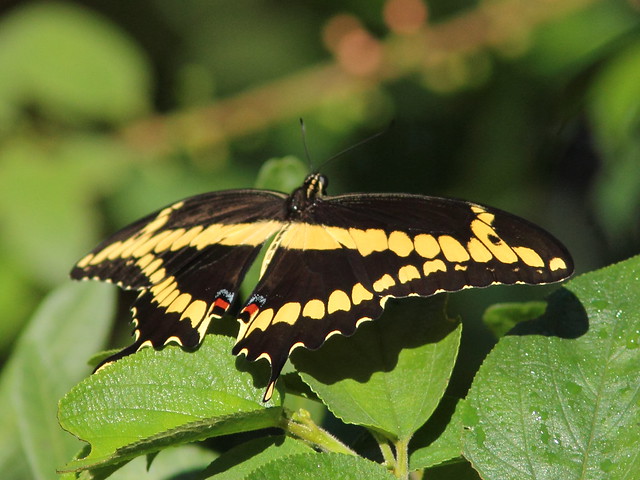Posted by: Ken @ 9:34 am
Before we left Illinois early in September, we had been experiencing heat and humidity that rivaled that in our Florida home. As soon as we got back to Florida, Illinois cooled off, but Florida seemed hotter than ever. With the arrival of autumn, heat and morning rain showers have reduced our time in the field.
At the same time, we have been more alert to happenings at the home front– particularly on the lake in back of our home, where an interesting drama played out. I noticed that a Double-crested Cormorant had caught a large exotic Plecostomus species. The 9-10 inch fish is native to the Amazon and popular in the pet trade, and has invaded south Florida waters. It struggled vigorously in the bird’s beak, its spiny fins fully extended. I do not know how long the fish had been in the cormorant’s grasp, but I watched intently to see if the bird could succeed in swallowing it, or whether it might get stuck in its gullet.
These photos cover a period of about 7 minutes. The bird won!
Cormorant takes on a Plecostomus (to see how the battle ended, CLICK HERE for a slide show):
Dodging a few raindrops, we did get out a couple of mornings this past week. Our first walk was the usual visit to the water conservation preserve next to our subdivision that we call the West Miramar Environmentally Sensitive Land (ESL). The sky overhead looked fine, but there were ominous clouds over the Everglades to the west.
At dawn, we entered the unpaved road that leads westward into the wetlands, and were greeted with this view:

We walked quickly at first, but stopped to look at a couple of roadside attractions.
A Loggerhead Shrike defecated just as I clicked the shutter:
This Eastern Kingbird looked atypical. It assumed a vertical elongated posture, unlike their usual more horizontal hunched attitude. Also, the terminal white band was almost invisible on its worn tail:
Mary Lou alerted me to the approach of a Red-shouldered Hawk, and I got the camera up just in time as it flew almost overhead:

We found the water level to be very high in the Harbour Lakes impoundment. The lake had flooded into the adjacent grasslands, and the mud flats had disappeared under a foot or two of water. We continued our “power walk,” but now moved more slowly as the sun rose higher and the sky turned blue.
This distant Great Egret was all alone on the lake:
We continued to the end of the road, and started walking the mile back to home. On the way, I tarried in the area of the “fake hammock,” and Mary Lou continued home without me. Again, I had to break through high grass, vines and tree branches that had proliferated at the edge of the woody patch.
As usual, the open space inside the “hammock” was shady and inviting:

An Ovenbird appeared in the open area and flew to a low perch:
The Ovenbird posed for almost a minute as I feverishly clicked off photos:
Several Florida Trema trees were producing berries in clusters along their stems. The fruit continues to ripen through the winter, and attracts insects and many migrating and resident birds, such as this Northern Cardinal: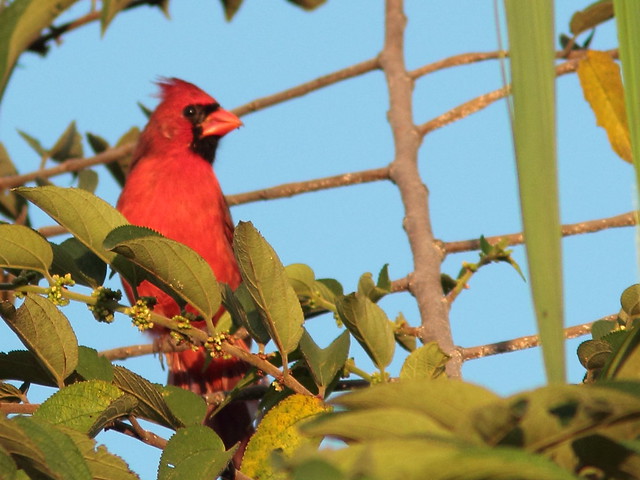
No less attractive, his mate was also partaking of the crop: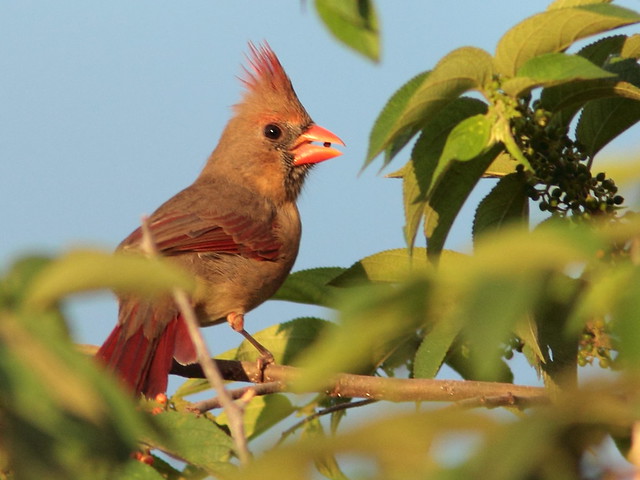
Against the sky, the iridescence of this Common Grackle was uncommonly beautiful:
A Red-bellied Woodpecker displaced the grackle on the perch:
Blue-gray Gnatcatchers had migrated in, and many will stay for the winter:
So far, we have not experienced a huge invasion of migrating warblers, but this female Black-throated Blue Warbler was a welcome visitor to a Trema tree: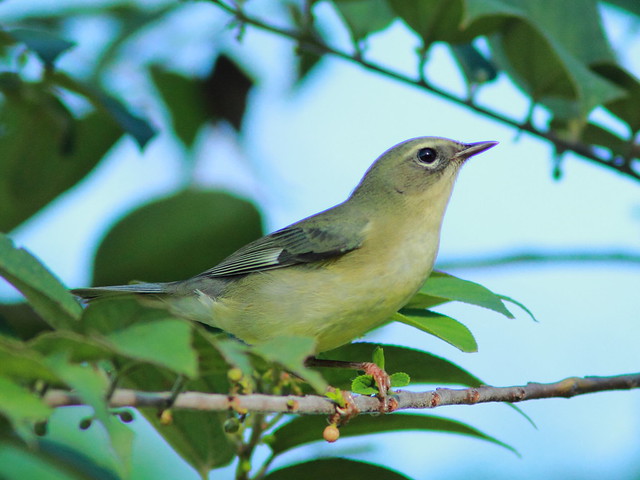
This was the best shot I could get of the male Black-throated Blue Warbler, as he never came out into the open: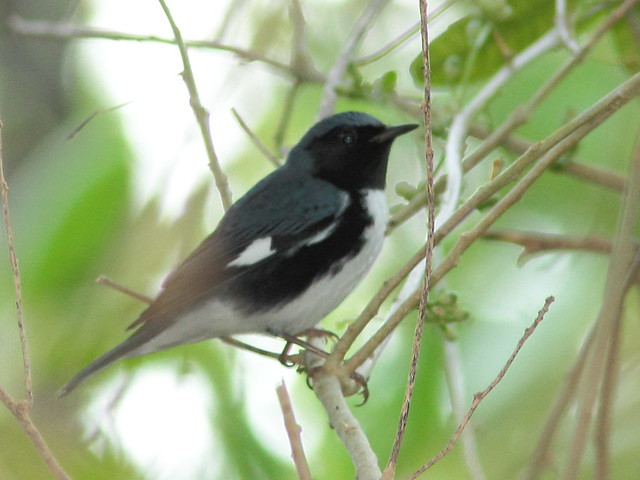
A female American Redstart, one of several I saw that morning, was unusually cooperative, striking a pose before dashing off after insects:
A male redstart was even more difficult to capture as it moved through the Trema branches:
Intent on my photography, I failed to notice that the skies had turned darker and a breeze began building. Too late for a retreat, I hunkered down in the most densely covered area as big drops started to fall. Lacking a camera bag or any rainproof clothing, I had to shield the camera with my body during what turned out to be only a brief downpour. Mental note– bring garbage bags out next time!
Photos came out soft in the mostly overcast skies. This is one of several Eastern Wood-Pewees I saw after the shower: 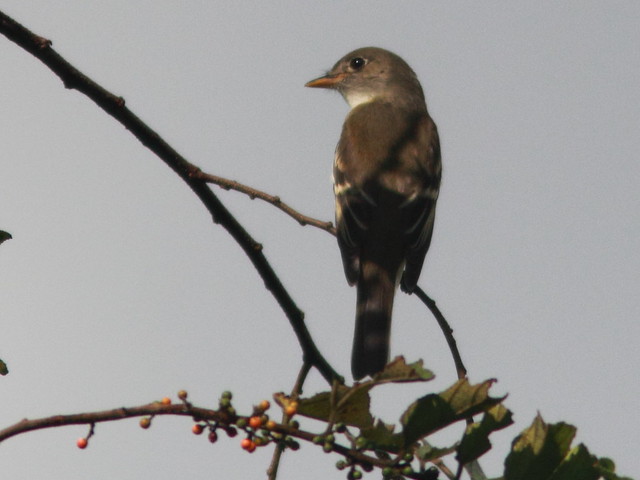
Another flycatcher showed up and it looked different. It seemed smaller than a Wood-Pewee, and and its eye ring was complete and more pronounced. It constantly flicked its tail downward, which would be unusual in a pewee. On close examination it appears to have shorter wings and shorter primary projection than a pewee, and its under-tail coverts are clear rather than smudged as with the Eastern Wood-Pewee.
It did not vocalize. I believe this is a Willow or Alder Flycatcher, reliably distinguished only by their calls (”Traill’s” complex): 
During lulls in birding, I paused to enjoy the insects, like this Zebra Heliconian:
I could not identify this tiny skipper, probably a member of the Grass-Skipper group:
This Giant Swallowtail is at the other end of the size spectrum:
Before the rains came, I got this nice shot of a garden spider and her handiwork:













